ECON 1269 - International Trade: Analysis of Trade Dynamics
VerifiedAdded on 2022/03/19
|18
|3315
|17
Homework Assignment
AI Summary
This individual assignment for ECON 1269 analyzes international trade dynamics, focusing on Vietnam's trade relationships and the impact of tariffs and trade agreements. The assignment begins with an analysis of the effects of tariffs on Vietnam's trade, using graphical representations to illustrate production and consumption equilibrium shifts. It then delves into Vietnam's trade with South Africa, examining key indicators, the Heckscher-Olin model, terms of trade, and income inequality. The analysis includes data from 2010 to 2019, exploring the GINI coefficient, poverty rates, and the Stolper-Samuelson theorem. Finally, the assignment discusses the Regional Comprehensive Economic Partnership (RCEP), evaluating its potential benefits and drawbacks for the UK, comparing it with the CPTPP, and concluding with recommendations for the UK's involvement in these trade agreements. The assignment uses data from various sources, including trading economics, trademap, and the OEC, to support its arguments.
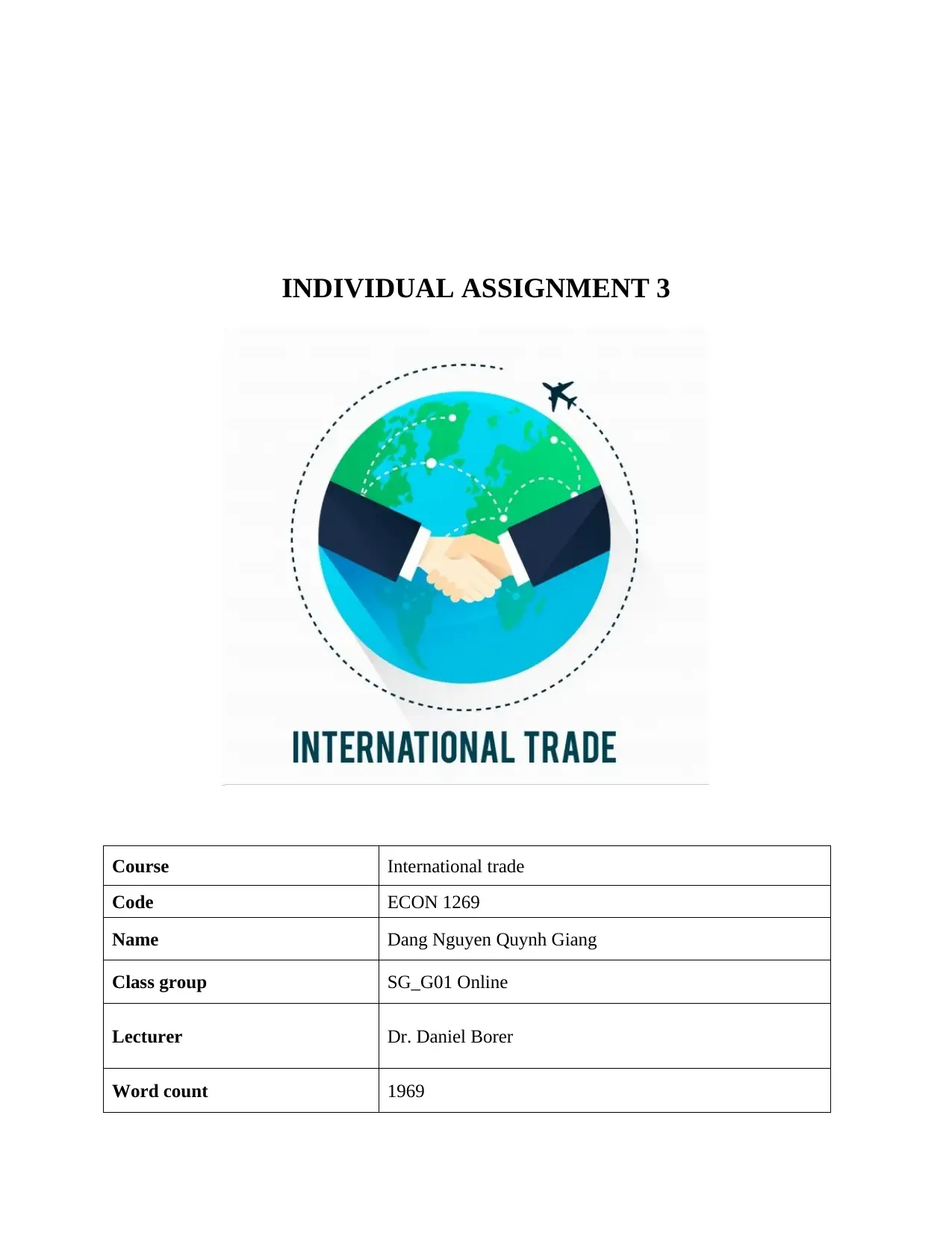
INDIVIDUAL ASSIGNMENT 3
Course International trade
Code ECON 1269
Name Dang Nguyen Quynh Giang
Class group SG_G01 Online
Lecturer Dr. Daniel Borer
Word count 1969
Course International trade
Code ECON 1269
Name Dang Nguyen Quynh Giang
Class group SG_G01 Online
Lecturer Dr. Daniel Borer
Word count 1969
Paraphrase This Document
Need a fresh take? Get an instant paraphrase of this document with our AI Paraphraser
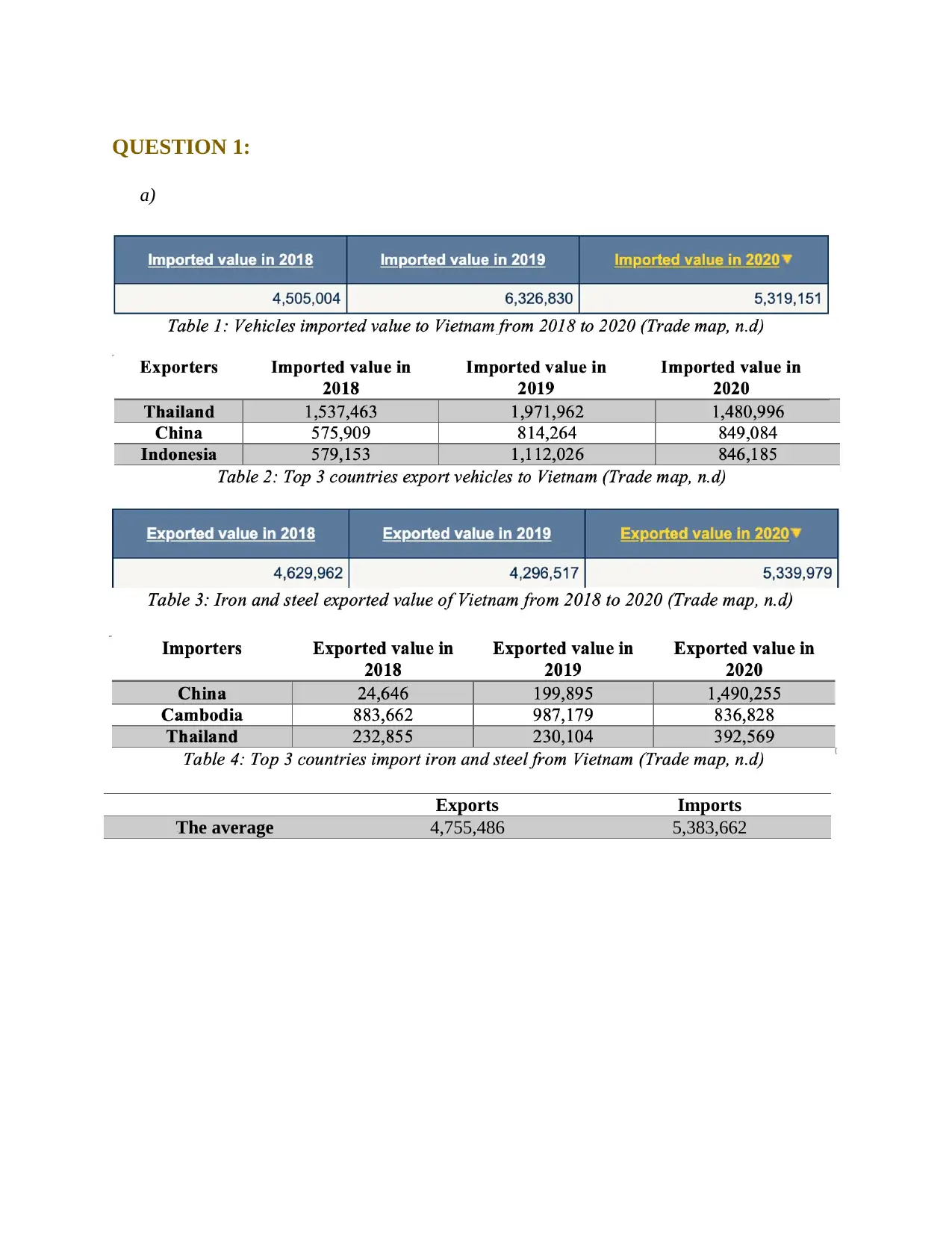
QUESTION 1:
a)
Exports Imports
The average 4,755,486 5,383,662
a)
Exports Imports
The average 4,755,486 5,383,662
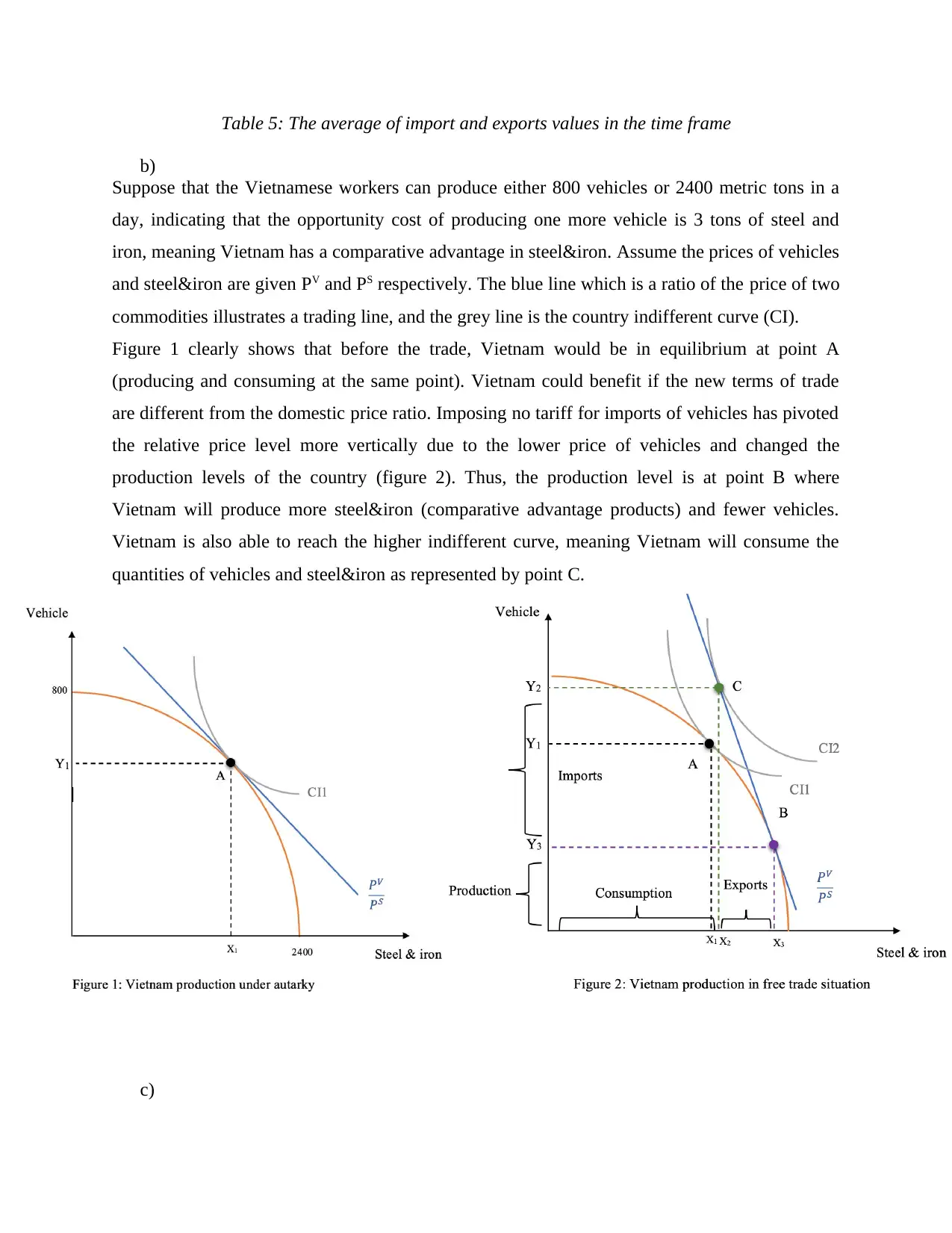
Table 5: The average of import and exports values in the time frame
b)
Suppose that the Vietnamese workers can produce either 800 vehicles or 2400 metric tons in a
day, indicating that the opportunity cost of producing one more vehicle is 3 tons of steel and
iron, meaning Vietnam has a comparative advantage in steel&iron. Assume the prices of vehicles
and steel&iron are given PV and PS respectively. The blue line which is a ratio of the price of two
commodities illustrates a trading line, and the grey line is the country indifferent curve (CI).
Figure 1 clearly shows that before the trade, Vietnam would be in equilibrium at point A
(producing and consuming at the same point). Vietnam could benefit if the new terms of trade
are different from the domestic price ratio. Imposing no tariff for imports of vehicles has pivoted
the relative price level more vertically due to the lower price of vehicles and changed the
production levels of the country (figure 2). Thus, the production level is at point B where
Vietnam will produce more steel&iron (comparative advantage products) and fewer vehicles.
Vietnam is also able to reach the higher indifferent curve, meaning Vietnam will consume the
quantities of vehicles and steel&iron as represented by point C.
c)
b)
Suppose that the Vietnamese workers can produce either 800 vehicles or 2400 metric tons in a
day, indicating that the opportunity cost of producing one more vehicle is 3 tons of steel and
iron, meaning Vietnam has a comparative advantage in steel&iron. Assume the prices of vehicles
and steel&iron are given PV and PS respectively. The blue line which is a ratio of the price of two
commodities illustrates a trading line, and the grey line is the country indifferent curve (CI).
Figure 1 clearly shows that before the trade, Vietnam would be in equilibrium at point A
(producing and consuming at the same point). Vietnam could benefit if the new terms of trade
are different from the domestic price ratio. Imposing no tariff for imports of vehicles has pivoted
the relative price level more vertically due to the lower price of vehicles and changed the
production levels of the country (figure 2). Thus, the production level is at point B where
Vietnam will produce more steel&iron (comparative advantage products) and fewer vehicles.
Vietnam is also able to reach the higher indifferent curve, meaning Vietnam will consume the
quantities of vehicles and steel&iron as represented by point C.
c)
⊘ This is a preview!⊘
Do you want full access?
Subscribe today to unlock all pages.

Trusted by 1+ million students worldwide

In figure 3, the implementation of a tariff of 65% on vehicles has rotated the relative price level
to the left due to the increase in the price of vehicles. As a small country, Vietnam can control its
consumer prices by implementing tariffs at the border while cannot affect the producer prices in
the world market. Thus, it can still trade with the rest of the world at the world relative price
ratio, leading to the new production line represented by the line parallel with the initial. The
production equilibrium shifts to D in which Vietnam produces a larger domestic quantity of
vehicles as the protective impact of tariff while there is a decrease in the production of steel and
iron. Consumption equilibrium shifts to E where the new price ratio becomes tangent to the
lower indifferent curve (CI3).
d)
The imposing tariff and adverse effects since Vietnam is a small country in the vehicle market.
The world prices exchanged for products are unchanged, implying benefits of the terms of trade
for Vietnam is failed to improve. One of the most negative impacts of tariff is the misallocation
of resources caused by the diversion of workers from the production of steel&iron industry
which Vietnam has comparative advantage and specialization. Moreover, due to the additional
to the left due to the increase in the price of vehicles. As a small country, Vietnam can control its
consumer prices by implementing tariffs at the border while cannot affect the producer prices in
the world market. Thus, it can still trade with the rest of the world at the world relative price
ratio, leading to the new production line represented by the line parallel with the initial. The
production equilibrium shifts to D in which Vietnam produces a larger domestic quantity of
vehicles as the protective impact of tariff while there is a decrease in the production of steel and
iron. Consumption equilibrium shifts to E where the new price ratio becomes tangent to the
lower indifferent curve (CI3).
d)
The imposing tariff and adverse effects since Vietnam is a small country in the vehicle market.
The world prices exchanged for products are unchanged, implying benefits of the terms of trade
for Vietnam is failed to improve. One of the most negative impacts of tariff is the misallocation
of resources caused by the diversion of workers from the production of steel&iron industry
which Vietnam has comparative advantage and specialization. Moreover, due to the additional
Paraphrase This Document
Need a fresh take? Get an instant paraphrase of this document with our AI Paraphraser

tariff, the imports are not only the elements that are reduced but also the exports of the country,
leading to the decrease in trade volume which not only negatively affect its international trade,
but also for the rest of the world. Finally, the consumption equilibrium is shifted to the lower
indifferent curve creates losses in welfare for Vietnam.
e)
When the domestic currency strengthens in relation to the world currencies, imports are cheaper
which encourages the Vietnamese to consume more foreign products, indicating that the imports
are expected to increase. When the import prices are lower, the consumers tend to pay less
money on foreign foods, leading to the pressure of keeping the low prices of domestic firms,
hence, lower inflation and improving the living standards. Moreover, the domestic producers will
produce more steel&iron and gain more benefits from exporting goods since the inelastic
demand for steel&iron and the appreciation of its currency. Finally, the demand for steel&iron
remains unchanged could reduce the risks of causing a trade deficit.
leading to the decrease in trade volume which not only negatively affect its international trade,
but also for the rest of the world. Finally, the consumption equilibrium is shifted to the lower
indifferent curve creates losses in welfare for Vietnam.
e)
When the domestic currency strengthens in relation to the world currencies, imports are cheaper
which encourages the Vietnamese to consume more foreign products, indicating that the imports
are expected to increase. When the import prices are lower, the consumers tend to pay less
money on foreign foods, leading to the pressure of keeping the low prices of domestic firms,
hence, lower inflation and improving the living standards. Moreover, the domestic producers will
produce more steel&iron and gain more benefits from exporting goods since the inelastic
demand for steel&iron and the appreciation of its currency. Finally, the demand for steel&iron
remains unchanged could reduce the risks of causing a trade deficit.
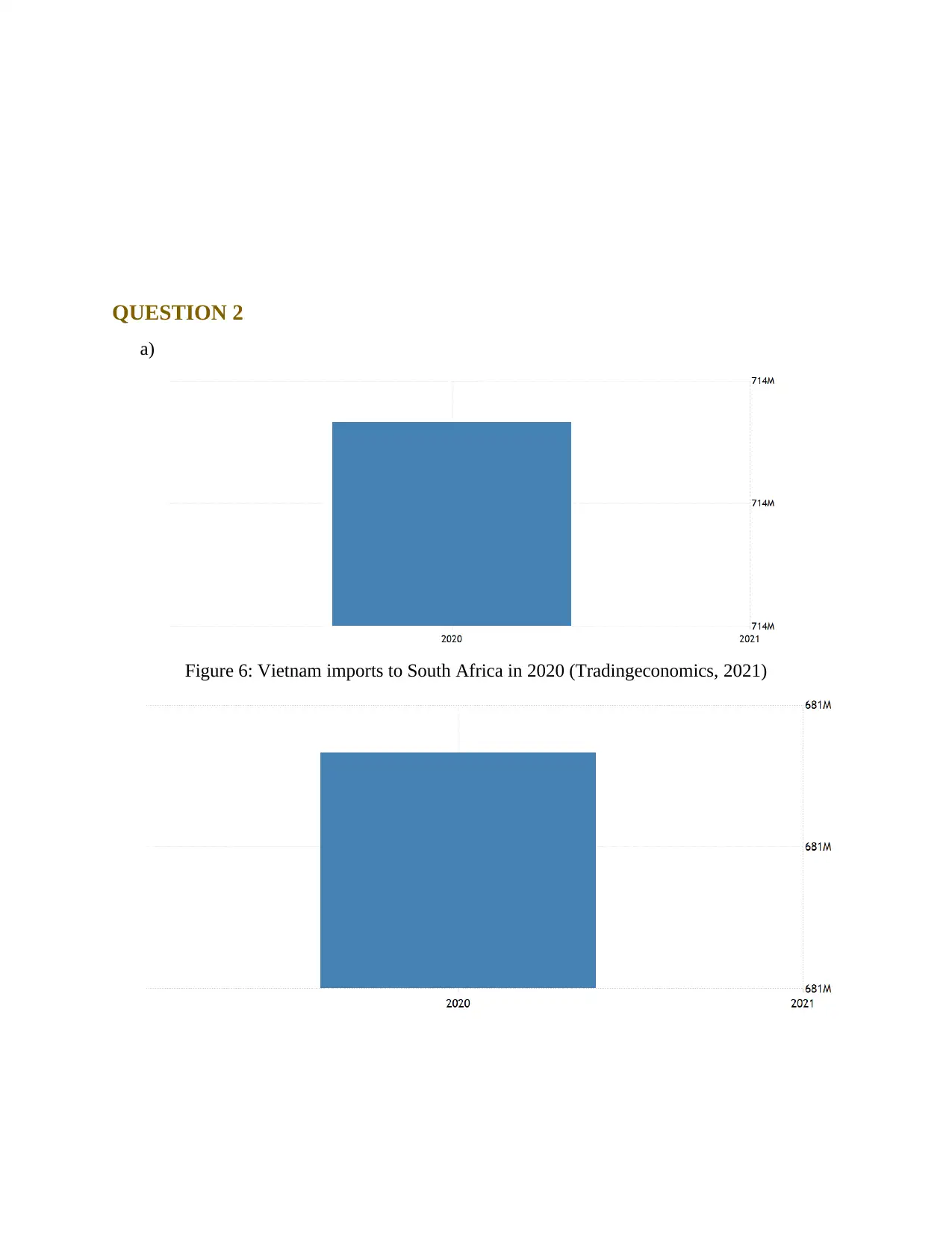
QUESTION 2
a)
Figure 6: Vietnam imports to South Africa in 2020 (Tradingeconomics, 2021)
a)
Figure 6: Vietnam imports to South Africa in 2020 (Tradingeconomics, 2021)
⊘ This is a preview!⊘
Do you want full access?
Subscribe today to unlock all pages.

Trusted by 1+ million students worldwide
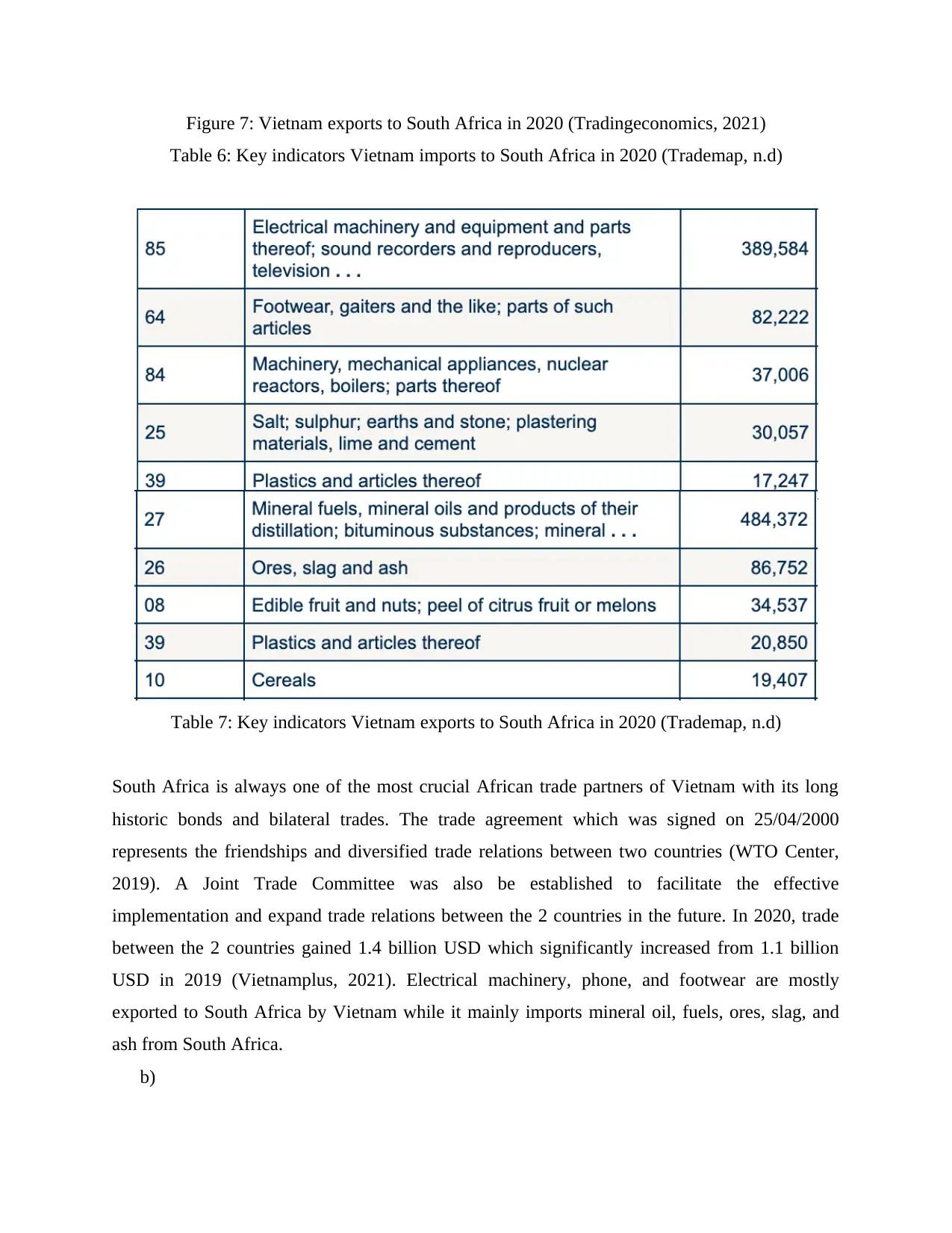
Figure 7: Vietnam exports to South Africa in 2020 (Tradingeconomics, 2021)
Table 6: Key indicators Vietnam imports to South Africa in 2020 (Trademap, n.d)
Table 7: Key indicators Vietnam exports to South Africa in 2020 (Trademap, n.d)
South Africa is always one of the most crucial African trade partners of Vietnam with its long
historic bonds and bilateral trades. The trade agreement which was signed on 25/04/2000
represents the friendships and diversified trade relations between two countries (WTO Center,
2019). A Joint Trade Committee was also be established to facilitate the effective
implementation and expand trade relations between the 2 countries in the future. In 2020, trade
between the 2 countries gained 1.4 billion USD which significantly increased from 1.1 billion
USD in 2019 (Vietnamplus, 2021). Electrical machinery, phone, and footwear are mostly
exported to South Africa by Vietnam while it mainly imports mineral oil, fuels, ores, slag, and
ash from South Africa.
b)
Table 6: Key indicators Vietnam imports to South Africa in 2020 (Trademap, n.d)
Table 7: Key indicators Vietnam exports to South Africa in 2020 (Trademap, n.d)
South Africa is always one of the most crucial African trade partners of Vietnam with its long
historic bonds and bilateral trades. The trade agreement which was signed on 25/04/2000
represents the friendships and diversified trade relations between two countries (WTO Center,
2019). A Joint Trade Committee was also be established to facilitate the effective
implementation and expand trade relations between the 2 countries in the future. In 2020, trade
between the 2 countries gained 1.4 billion USD which significantly increased from 1.1 billion
USD in 2019 (Vietnamplus, 2021). Electrical machinery, phone, and footwear are mostly
exported to South Africa by Vietnam while it mainly imports mineral oil, fuels, ores, slag, and
ash from South Africa.
b)
Paraphrase This Document
Need a fresh take? Get an instant paraphrase of this document with our AI Paraphraser
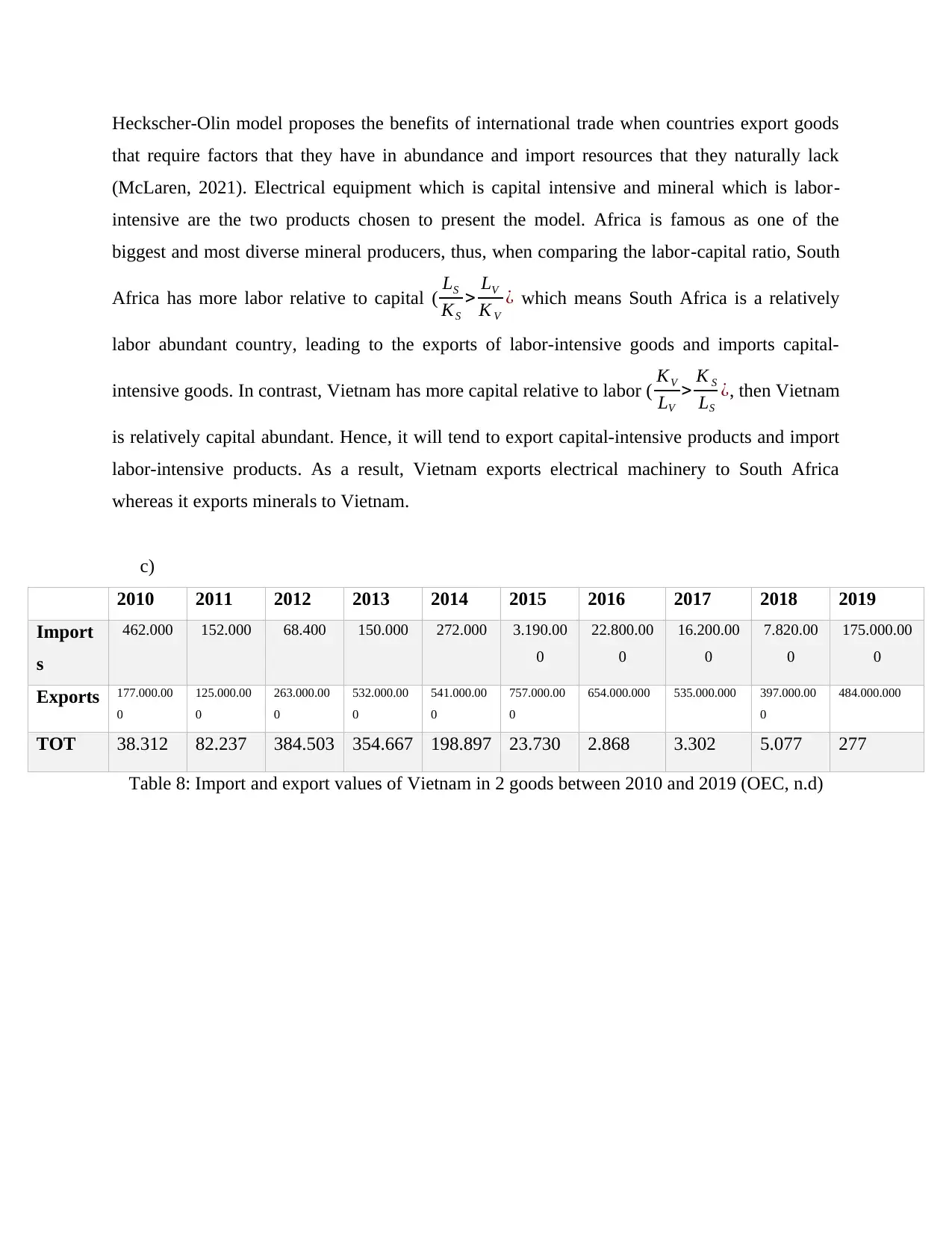
Heckscher-Olin model proposes the benefits of international trade when countries export goods
that require factors that they have in abundance and import resources that they naturally lack
(McLaren, 2021). Electrical equipment which is capital intensive and mineral which is labor-
intensive are the two products chosen to present the model. Africa is famous as one of the
biggest and most diverse mineral producers, thus, when comparing the labor-capital ratio, South
Africa has more labor relative to capital ( LS
KS
> LV
K V
¿ which means South Africa is a relatively
labor abundant country, leading to the exports of labor-intensive goods and imports capital-
intensive goods. In contrast, Vietnam has more capital relative to labor ( KV
LV
> K S
LS
¿, then Vietnam
is relatively capital abundant. Hence, it will tend to export capital-intensive products and import
labor-intensive products. As a result, Vietnam exports electrical machinery to South Africa
whereas it exports minerals to Vietnam.
c)
2010 2011 2012 2013 2014 2015 2016 2017 2018 2019
Import
s
462.000 152.000 68.400 150.000 272.000 3.190.00
0
22.800.00
0
16.200.00
0
7.820.00
0
175.000.00
0
Exports 177.000.00
0
125.000.00
0
263.000.00
0
532.000.00
0
541.000.00
0
757.000.00
0
654.000.000 535.000.000 397.000.00
0
484.000.000
TOT 38.312 82.237 384.503 354.667 198.897 23.730 2.868 3.302 5.077 277
Table 8: Import and export values of Vietnam in 2 goods between 2010 and 2019 (OEC, n.d)
that require factors that they have in abundance and import resources that they naturally lack
(McLaren, 2021). Electrical equipment which is capital intensive and mineral which is labor-
intensive are the two products chosen to present the model. Africa is famous as one of the
biggest and most diverse mineral producers, thus, when comparing the labor-capital ratio, South
Africa has more labor relative to capital ( LS
KS
> LV
K V
¿ which means South Africa is a relatively
labor abundant country, leading to the exports of labor-intensive goods and imports capital-
intensive goods. In contrast, Vietnam has more capital relative to labor ( KV
LV
> K S
LS
¿, then Vietnam
is relatively capital abundant. Hence, it will tend to export capital-intensive products and import
labor-intensive products. As a result, Vietnam exports electrical machinery to South Africa
whereas it exports minerals to Vietnam.
c)
2010 2011 2012 2013 2014 2015 2016 2017 2018 2019
Import
s
462.000 152.000 68.400 150.000 272.000 3.190.00
0
22.800.00
0
16.200.00
0
7.820.00
0
175.000.00
0
Exports 177.000.00
0
125.000.00
0
263.000.00
0
532.000.00
0
541.000.00
0
757.000.00
0
654.000.000 535.000.000 397.000.00
0
484.000.000
TOT 38.312 82.237 384.503 354.667 198.897 23.730 2.868 3.302 5.077 277
Table 8: Import and export values of Vietnam in 2 goods between 2010 and 2019 (OEC, n.d)
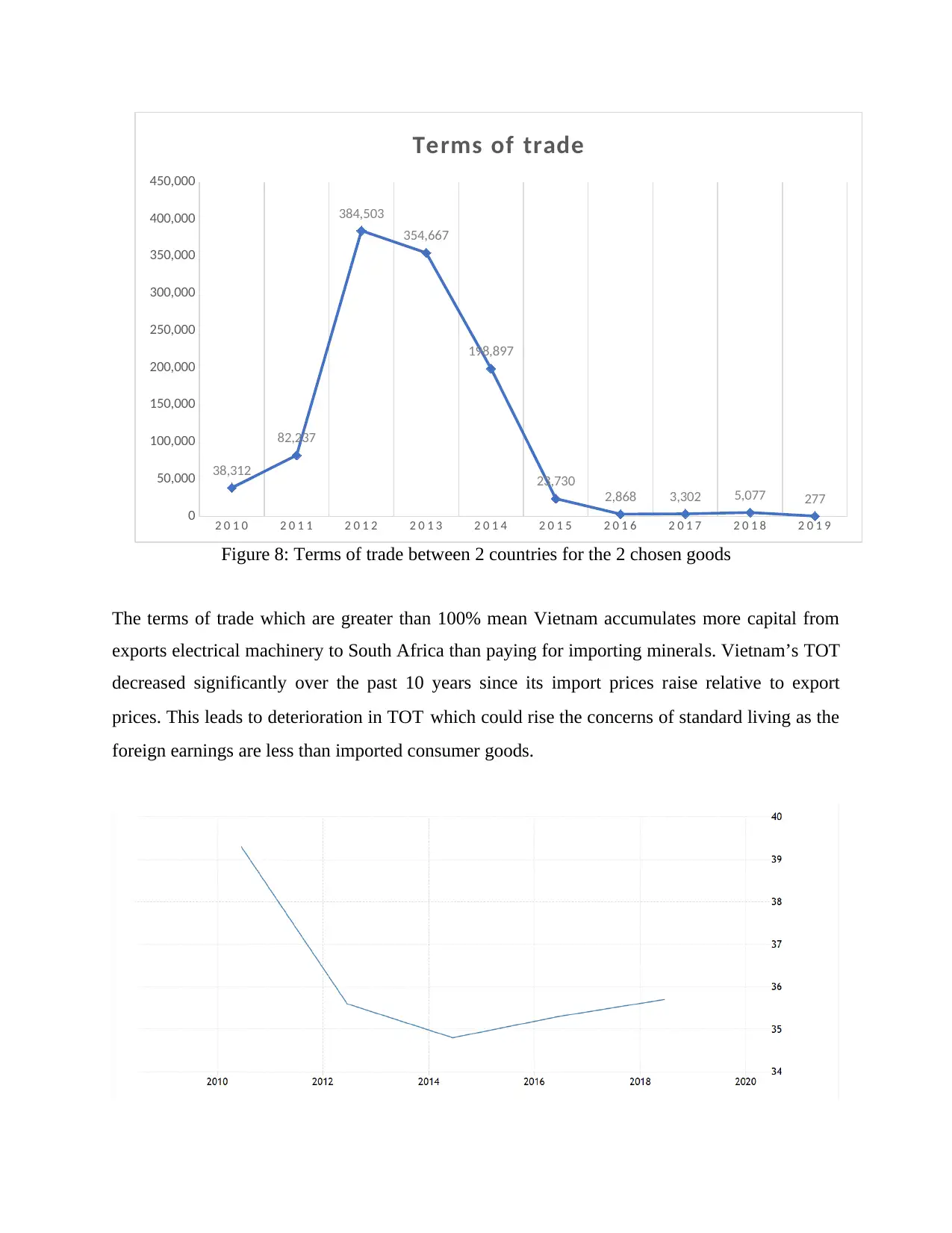
Figure 8: Terms of trade between 2 countries for the 2 chosen goods
The terms of trade which are greater than 100% mean Vietnam accumulates more capital from
exports electrical machinery to South Africa than paying for importing minerals. Vietnam’s TOT
decreased significantly over the past 10 years since its import prices raise relative to export
prices. This leads to deterioration in TOT which could rise the concerns of standard living as the
foreign earnings are less than imported consumer goods.
2 0 1 0 2 0 1 1 2 0 1 2 2 0 1 3 2 0 1 4 2 0 1 5 2 0 1 6 2 0 1 7 2 0 1 8 2 0 1 9
0
50,000
100,000
150,000
200,000
250,000
300,000
350,000
400,000
450,000
38,312
82,237
384,503
354,667
198,897
23,730
2,868 3,302 5,077 277
Terms of trade
The terms of trade which are greater than 100% mean Vietnam accumulates more capital from
exports electrical machinery to South Africa than paying for importing minerals. Vietnam’s TOT
decreased significantly over the past 10 years since its import prices raise relative to export
prices. This leads to deterioration in TOT which could rise the concerns of standard living as the
foreign earnings are less than imported consumer goods.
2 0 1 0 2 0 1 1 2 0 1 2 2 0 1 3 2 0 1 4 2 0 1 5 2 0 1 6 2 0 1 7 2 0 1 8 2 0 1 9
0
50,000
100,000
150,000
200,000
250,000
300,000
350,000
400,000
450,000
38,312
82,237
384,503
354,667
198,897
23,730
2,868 3,302 5,077 277
Terms of trade
⊘ This is a preview!⊘
Do you want full access?
Subscribe today to unlock all pages.

Trusted by 1+ million students worldwide

Figure 9: Vietnam GINI index between 2010 and 2019
Figure 10: Lorenz curve for Vietnam
Figure 10: Lorenz curve for Vietnam
Paraphrase This Document
Need a fresh take? Get an instant paraphrase of this document with our AI Paraphraser

Figure 11: South Africa GINI index between 2010 and 2019
Figure 12: Lorenz curve for South Africa
There is a significant decrease in the GINI coefficient of Vietnam in 2014 before it rose again in
2015, indicating that the income gap in Vietnam has been improved over the past 10 years.
Although South Africa witnessed the same trend as a sharp fall in the GINI index from 2010 to
Figure 12: Lorenz curve for South Africa
There is a significant decrease in the GINI coefficient of Vietnam in 2014 before it rose again in
2015, indicating that the income gap in Vietnam has been improved over the past 10 years.
Although South Africa witnessed the same trend as a sharp fall in the GINI index from 2010 to

2014, it is still the high record due to the apartheid issues and the present government’s
governance styles. Thus, Vietnam has a much fairer in income than South Africa.
Figure 13: Poverty rate of Vietnam (Macrotrends, n.d)
Figure 14: Poverty rate of South Africa (Macrotrends, n.d)
governance styles. Thus, Vietnam has a much fairer in income than South Africa.
Figure 13: Poverty rate of Vietnam (Macrotrends, n.d)
Figure 14: Poverty rate of South Africa (Macrotrends, n.d)
⊘ This is a preview!⊘
Do you want full access?
Subscribe today to unlock all pages.

Trusted by 1+ million students worldwide
1 out of 18
Related Documents
Your All-in-One AI-Powered Toolkit for Academic Success.
+13062052269
info@desklib.com
Available 24*7 on WhatsApp / Email
![[object Object]](/_next/static/media/star-bottom.7253800d.svg)
Unlock your academic potential
Copyright © 2020–2025 A2Z Services. All Rights Reserved. Developed and managed by ZUCOL.





